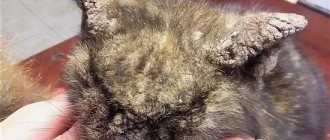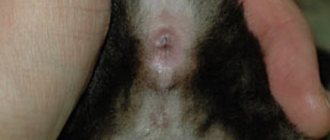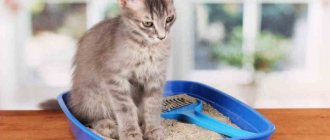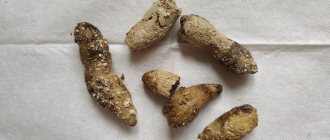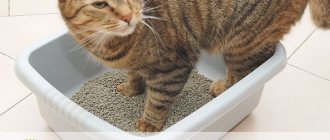24973Administration
6
A pet's illness always brings owners a lot of worries and troubles. A cheerful and mischievous pet suddenly becomes sad and lethargic - this is familiar to many. What if a cat vomits white foam? From a medical point of view, the gag reflex is considered as a natural physiological process that helps the animal empty its stomach.
There may be several reasons that provoke white vomiting. If white foamy vomiting in a cat is repeated many times, this may indicate some kind of disease and cannot be avoided without the help of a veterinarian.
Causes of vomiting in cats and kittens
Vomiting white foam in cats and kittens can be a protective reaction to the entry of pathogenic bacteria and irritating substances into the digestive system.
This symptom may appear if the animal has eaten something wrong. Pay attention to the vomit. Don't worry if the white foam is a smooth consistency. This may mean a temporary disruption to the digestive system.
Let's look at why a kitten may vomit white foam:
- Overeating, feeding too large pieces of food.
- Hunger. If an animal does not eat for a long enough time, gastric juice begins to irritate the mucous membranes of the digestive organs. As a result, the kitten vomits white foam.
- Too abrupt a transition from one diet to another.
- Feeding food that is harmful to the kitten (fatty, fried, smoked).
- Stale food, ready-made economy class rations.
- Eating inedible objects.
- Poisoning with chemicals (household chemicals, medications, alcohol).
- Consequences of vaccination.
- Inflammatory diseases of the gastrointestinal tract. Symptoms appear immediately after feeding. The kitten first burps, then vomits. If severe diarrhea is added to vomiting, the animal may die.
- Kidney diseases. Vomiting is accompanied by thirst and difficulty urinating.
- Infectious diseases. The most dangerous are feline distemper and panleukopenia, which can be fatal. The kitten vomits white or yellowish foam, attacks occur quite often.
- Respiratory diseases of viral, bacterial etiology. In this case, vomiting is accompanied by a cough, and a small amount of blood is present in the foam.
- Inflammatory diseases of the adrenal glands. The result is a disruption of the normal process of cortisone synthesis, which is accompanied by vomiting, diarrhea, and muscle weakness.
- Worm infestation. Vomiting is caused by toxins that are formed during the life of parasites.
A possible cause of vomiting may be a large amount of fur entering the stomach if the animal licks itself frequently. This process is typical for long-haired animals.
Carrying out prevention
Prevention of sudden attacks of the gag reflex is carried out with the help of:
- regular anti-worm therapy. For cats walking outside every 3 months;
- annual vaccinations, preventive examinations at a veterinary clinic for timely detection of hidden diseases;
- proper nutrition. Balanced ready-made food in sufficient quantities will help avoid pathological conditions;
- pet care. Brushing will prevent the accumulation of hairballs in the stomach;
- maintaining hygiene in the home. A clean room and no small objects that the cat could swallow.
Combing
White foam along with the contents of the stomach can have both physiological and pathological origin. The appearance of accompanying clinical signs requires seeking professional help and undergoing a full diagnostic examination. Timely treatment will avoid complications and save the life of your pet.
What to do if your cat is vomiting?
So, what should you do if your cat is vomiting white foam? Observe your pet for 24 hours. If your cat vomits but is still acting normally, signs of discomfort may disappear the next day.
If you suspect poisoning or an exacerbation of gastrointestinal diseases, you can try to help the cat by giving it a fasting day. This will restore the functioning of the damaged organ.
The next day, the animal’s condition should return to normal and the vomiting should stop. On the first day after the fasting day, give your cat rice cooked in chicken broth.
Feed your pet more often (up to 6 times a day), in small portions. In subsequent days, reduce the number of feedings and increase the amount of food. Then gradually transition the cat to a regular diet.
If the vomiting was caused by a common stomach upset, give your pet a mint infusion. Pour 1 teaspoon of herb into 1 cup of boiling water and leave until cool. The drink should be warm. Give your cat 1 tablespoon immediately after vomiting.
How to protect a cat from poisoning
Any disease is easier to prevent than to treat, so attention should be paid to the prevention of diseases and poisoning. To protect your cat from poisoning and digestive disorders, you should adhere to the following rules:
- Give the animal only healthy and fresh food. If you use dry food for feeding, then you should not skimp on it; you need to choose high-quality products.
- Do not overfeed fluffies and especially kittens; portions should be appropriate for age and weight.
- Food should be lukewarm and finely chopped.
- Periodically, cats are given anthelmintic drugs.
- All vaccinations are given according to schedule.
If trouble happens and your beloved cat gets sick, you need to act quickly. In most cases, the health of the animal and its life depend on the coordinated actions of the owner. When your pet's condition worsens by the minute, you need to quickly go to the hospital.
In what cases should you contact a veterinarian?
The situation becomes more complicated when the pet feels sick and vomits for more than a day, it becomes weak and lethargic and looks sick. If the cat does not go to the toilet or does not allow his stomach to be touched, you should urgently contact a veterinarian.
Other reasons to contact a specialist:
- After a starvation diet, the pet’s condition does not improve; he often vomits (several times an hour).
- If your cat doesn't eat anything all day. In this case, foamy vomit is most likely a sign of a serious illness.
- Vomiting is accompanied by severe thirst, and the cat does not go to the litter box. This indicates kidney pathology.
- Diarrhea, fever (above 38-39 ºС).
- Cramps. The symptom indicates damage to the central nervous system.
- Bloody discharge can be seen in the vomit.
- If your cat regularly spits up fur, his digestive system is not working properly. Your pet may have diseases of the gallbladder, pancreas or rectum.
Vomiting that does not stop for more than a day leads to dehydration. This condition poses a serious threat to life.
The following sign indicates severe dehydration with prolonged vomiting: lift an area of skin with your fingers and release it, it will slowly return to its original shape.
To prevent the death of the animal, you should not self-medicate. Be sure to show your cat to a veterinarian, who will determine the cause of vomiting and provide adequate therapy.
Preventing the gag reflex
Preventative measures to prevent the occurrence of an unpleasant gag reflex in pets include:
- Annual vaccination, anthelmintic therapy every 3 months.
- Regular visits to the veterinarian for preventive purposes.
- Sufficient, high-quality and balanced feeding of the pet, for dessert - a special herb for cleansing and healing the cat’s body.
- Systematic care of cat hair - bathing, combing, cutting if necessary.
- Cleanliness and hygiene in the house, small items should not be in the free access of the animal.
A responsible and competent owner will always come to the aid of a sick pet, because people are responsible for those they have tamed. Knowing a lot about white foam and vomiting, its causes and consequences, you can start treatment on time, react correctly to what happened and prevent complications. Then your pet will be happy again and give a smile to others!
IMPORTANT! VETERINARIAN CONSULTATION REQUIRED. INFORMATION FOR INFORMATION ONLY. Administration Share with friends Article rating (1 ratings, average: 5.00 out of 5)
Vomits white foam
What to do if your cat is vomiting yellow foam?
If a cat vomits yellow foam, it means that bile has entered its stomach. The cause is diseases of the gastrointestinal tract (gastritis, colitis), biliary tract.
Yellowish vomiting in a cat can occur due to calcivirosis, a sudden change in diet, or a foreign body entering the stomach. If your pet has eaten stale or low-quality food, the load on the liver increases. In this case, vomiting of yellow liquid may also occur.
If you suspect that an inedible object or poor-quality food has entered the stomach, you need to provoke vomiting.
Give the animal a saline solution. To prepare it, stir 1 tablespoon of salt in 1 glass of warm water. Drink the solution until the cat begins to vomit.
If vomiting yellow foam was caused by poisoning, give your pet activated charcoal. In case of exacerbations of gastrointestinal diseases, exclude rough, fatty foods from the animal’s diet.
In severe cases, when vomiting with yellow foam was caused by infections, the cat should be taken to the veterinarian. In this case, you need to make droppers with saline solutions and medications.
First aid for an animal
Supportive measures depend on the root causes of deterioration in health:
- in case of poisoning - activated carbon is crushed, dissolved and given to the pet using a syringe (1 tablet per 10 kg of weight);
- in case of paroxysmal short-term vomiting, balance is restored with rehydron solution;
- a weakened pet is supported with injections of ringer's solution, atoxil and enterosgel.
Important! If a cat’s condition continues for more than 48 hours, then it must be taken to the veterinarian. Further self-medication can lead to the death of the animal.
In any critical situation, it is better to show the animal to a veterinarian
Diagnostics
When contacting a veterinary clinic, you need to provide the specialist with the following information:
- What did the cat feed, were there any changes in the diet.
- How often did vomiting occur?
- Are there any chronic diseases or infections in the animal that the owner is aware of?
This will help establish an accurate diagnosis and take the necessary measures.
Diagnosis of the pathological condition of a cat is as follows:
- analysis of the type and consistency of vomit;
- examination of the cat, analysis of the general condition;
- laboratory tests of blood, urine;
- Ultrasound of the abdominal cavity, kidneys.
The treatment regimen is selected depending on the established diagnosis. It includes drug therapy and measures to prevent dehydration.
During the treatment of vomiting in a cat, a special diet is necessary. Food should be semi-liquid. Feed your pet more often, in small portions. Meat should only be given boiled and chopped. After stabilization of the condition, the transition to the usual diet should be gradual.
Necessary treatment
When a cat vomits yellow liquid mixed with foam, you should not ignore this phenomenon. If the animal burps once, then therapy can be carried out at home. In advanced cases, treatment is selected by a veterinarian. It is important for the specialist to first clarify the patient’s nutritional characteristics and the presence/absence of vaccinations. To find out the reason why the cat vomited, laboratory and instrumental examinations are prescribed.
If an animal has food poisoning, you can give it Enetrosgel.
When the problem is caused by drug or food poisoning, you need to give the animal activated charcoal or Enterosgel. If a sick cat is not eating, you should not try to force feed it. It is recommended to refrain from eating for several hours, or even days, so as not to provoke vomiting again. When a cat vomits white foam, the following veterinary medications are used, listed in the table.
| Drug group | Name |
| Solution for restoring water balance | "Regidron" |
| "Atoxil" | |
| Antiemetics | "Torekan" |
| "Paspertine" | |
| "Phenothiazine" | |
| Medicines for intramuscular injections | "Cerucal" |
Veterinarians recommend taking antibiotics and sulfa drugs for prolonged and severe vomiting with foam associated with gastrointestinal pathologies. If severe intoxication is detected, then the disorder must be treated with intravenous glucose.
Many owners panic when their cat vomits white foam. There are many primary sources of deviation, and it is not always associated with complex diseases. In some cases, the gag reflex is caused by physiological factors.


